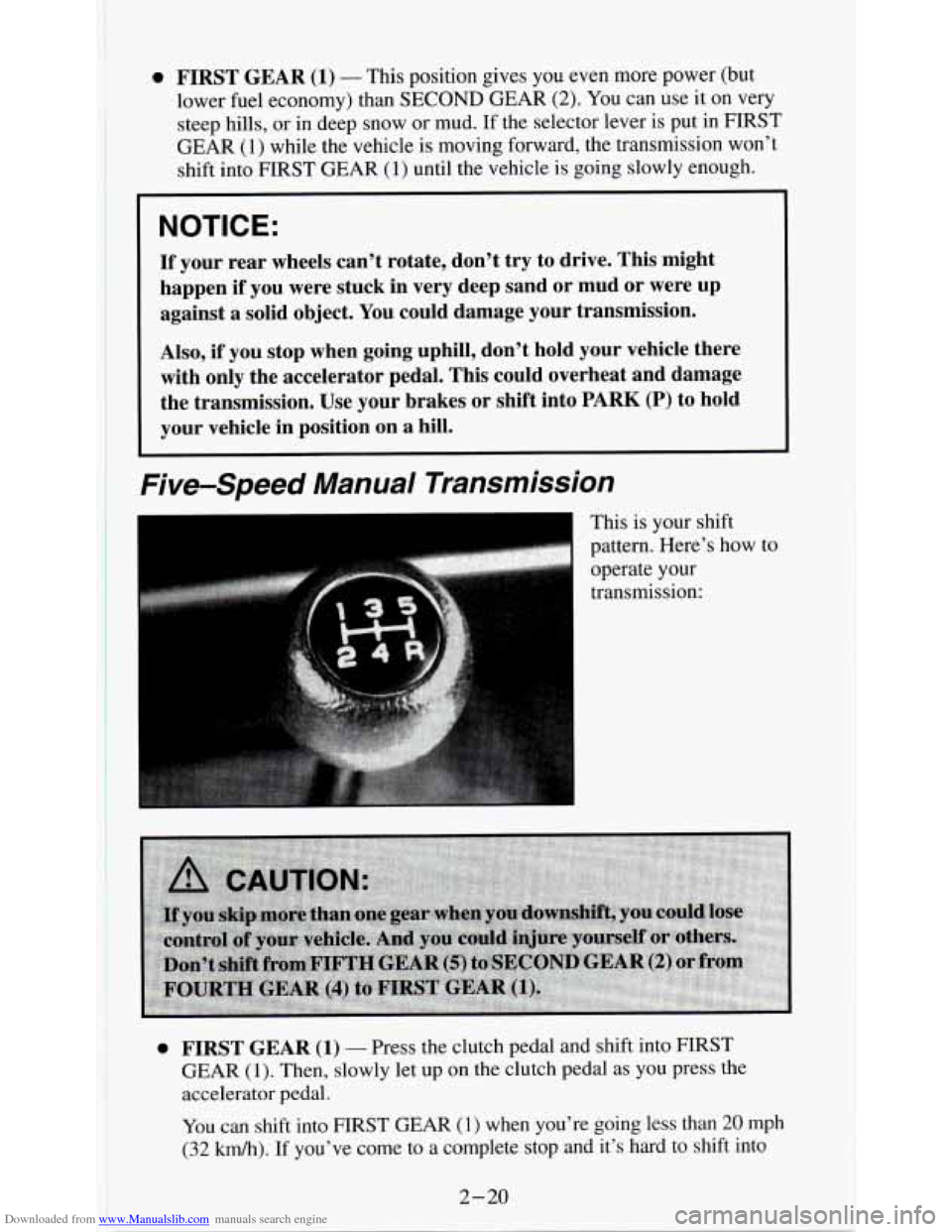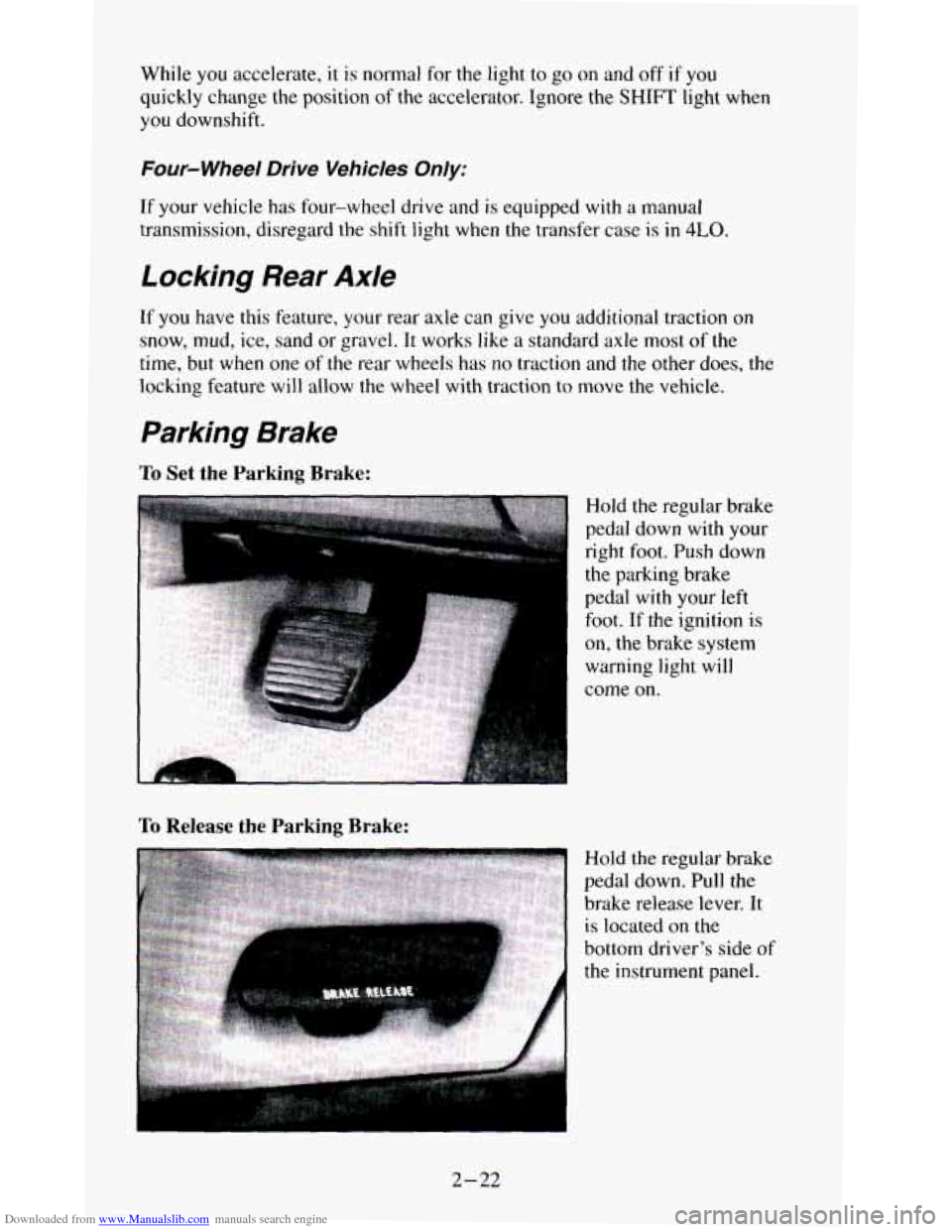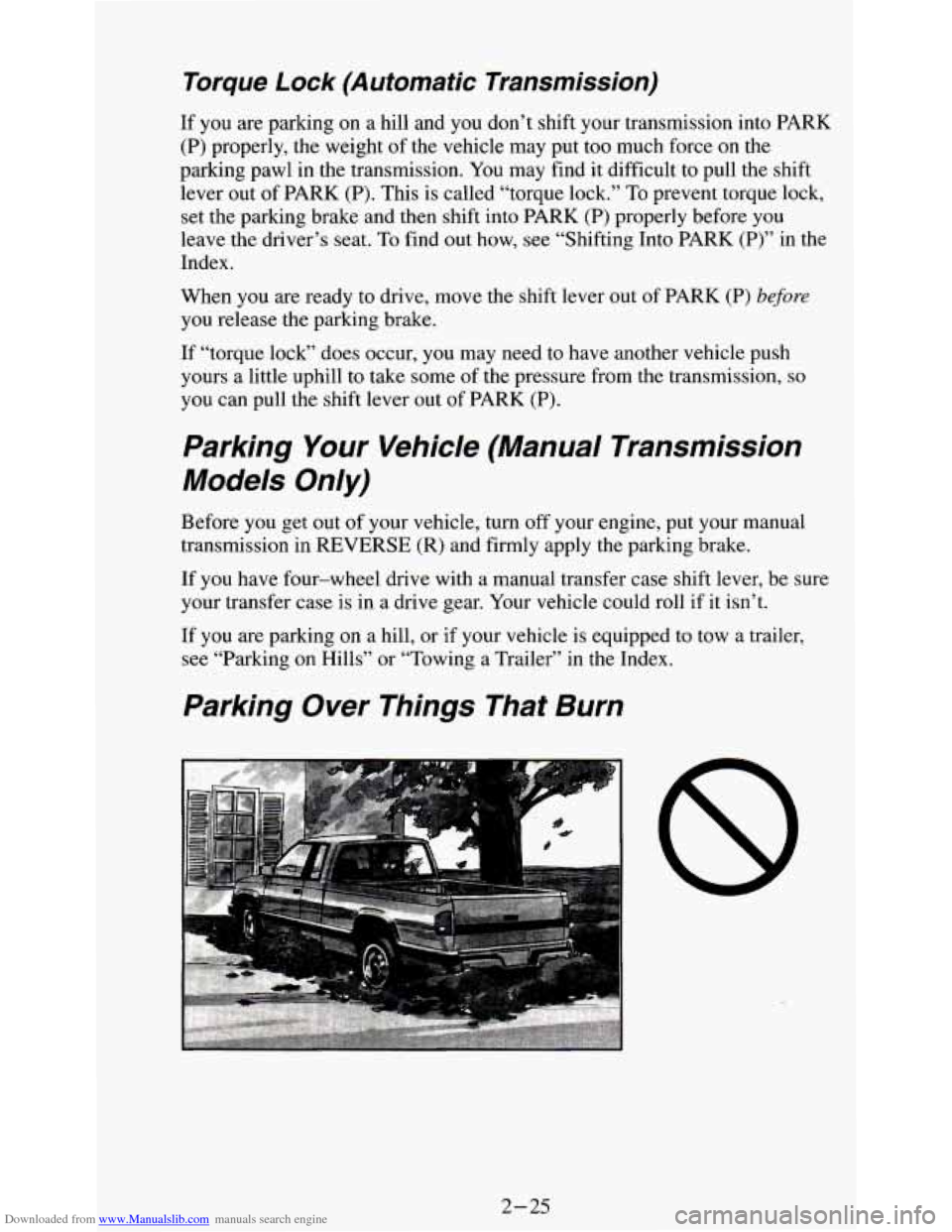Page 63 of 354

Downloaded from www.Manualslib.com manuals search engine A CAUTION:
It is dangerous to get out of your vehicle if the shift lever is not
fully in
PARK (P) with the parking brake firmly set, Your
vehicle can roll.
Don’t leave your vehicle when the engine
is running unless you
have to.
If you have left the engine running, the vehicle can move
suddenly.
You or others could be injured. To be sure your vehicle
won’t move, even when you’re on
fairly level ground, always set
your parking brake and move the shift lever to
PARK (P),
If you have four-wheel drive, your vehicle will be free to roll -
even if your shift lever is in PARK (P) - if your transfer case is
in NEUTRAL (N). So, be sure the transfer case is in a drive gear,
two-wheel high (2HI) or four-wheel high (4HI) or four-wheel
low
(4LO) - not in NEUTRAL (N). See “Shifting Into PARK
(P)” in the Index. If you’re pulling a trailer, see “Towing a
Trailer” in the Index.
REVERSE (R) - Use this gear to back up.
NOTICE:
Shifting to REVERSE (R) while your vehicle is moving forward
could damage your transmission. Shift
to REVERSE (R) only
after your vehicle is stopped.
To rock your vehicle back and forth to get out of snow, ice or sand
without damaging your transmission,
see “If You’re Stuck: In Sand,
Mud, Ice or
Snow” in the Index.
0 NEUTRAL (N) - In this position, your engine doesn’t connect with
the wheels.
To restart when you’re already moving, use NEUTRAL (N)
only. Also, use NEUTRAL (N) when your vehicle is being towed.
2- 18
Page 64 of 354

Downloaded from www.Manualslib.com manuals search engine NOTICE:
Damage to your transmission caused by shifting out of PARK
(P) or NEUTRAL (N) with the engine racing isn’t covered by
your warranty.
0 OVERDRIVE (@) - This position is for normal driving. If you need
more power for passing, and you’re:
- Going less than about 35 mph (56 kdh), push your accelerator
pedal about halfway down.
- Going about 35 mph (56 kdh) or more, push the accelerator all
the way down.
You’ll shift down to the next gear and have more power.
OVERDRIVE
(a) should not be used when towing a trailer,
carrying
a heavy load, driving on steep hills, or for off-road
driving. Select DRIVE
(D) when operating the vehicle under any
of these conditions.
DRIVE (D) - This is like @, but you never go into Overdrive. You
should use DRIVE
(D) when towing a trailer, carrying a heavy load,
driving on steep hills, or for off-road driving.
0 SECOND GEAR (2) - This position gives you more power but lower
fuel economy. You can use SECOND GEAR (2) on hills. It can help
control your speed
as you go down steep mountain roads, but then you
would
also want to use your brakes off and on.
If you manually select SECOND GEAR (2), the transmission will drive
in second gear. You may use this feature for reducing torque to the rear
wheels when
you are trying to start your vehicle from a stop on
slippery road surfaces.
2- 19
Page 65 of 354

Downloaded from www.Manualslib.com manuals search engine 0 FIR$T GEAR (1) - This position gives you even more power (but
lower fuel economy) than
SECOND GEAR (2). You can use it on very
steep hills, or in deep snow or mud. If the selector lever is put in
FIRST
GEAR (1) while the vehicle is moving forward, the transmission won’t
shift into FIRST
GEAR (1) until the vehicle is going slowly enough.
NOTICE:
If your rear wheels can’t rotate, don’t try to drive. This might
happen
if you were stuck in very deep sand or mud or were up
against a solid object.
You could damage your transmission.
Also, if you stop when going uphill, don’t hold your vehicle there
with only the accelerator pedal. This could overheat and damage
the transmission. Use your brakes or shift into PARK
(P) to hold
your vehicle in position on a hill.
Five-Speed Manual Transmission
This is your shift
pattern. Here’s how to
operate your
transmission:
0 FIRST GEAR (1) - Press the clutch pedal and shift into FIRST
GEAR (1). Then, slowly let up on the clutch pedal as you press the
accelerator pedal.
You can shift into FIRST GEAR (1) when you’re going less than\
20 mph
(32 km/h). If you’ve come to a complete stop and it’s hard to shift into
1 2-20
I
Page 67 of 354

Downloaded from www.Manualslib.com manuals search engine While you accelerate, it is normal for the light to go on and off if you
quickly change the position of the accelerator. Ignore the SHIFT light when
you downshift.
Four- Wheel Drive Vehicles Only:
If your vehicle has four-wheel drive and is equipped with a manual
transmission, disregard the shift light when the transfer case is in
4LO.
Locking Rear Axle
If you have this feature, your rear axle can give you additional traction on
snow, mud, ice, sand or gravel. It
works like a standard axle most of the
time, but when one
of the rear wheels has no traction and the other does, the
locking feature will allow the wheel with traction
to move the vehicle.
Parking Brake
To Set the Parking Brake:
To Release the Parking Brake:
Hold the regular brake
pedal down with your
right
foot. Push down
the parking brake
pedal
with your left
foot. If the ignition is
on, the brake system
warning light will
come on.
Hold the regular brake
pedal down. Pull the
brake release lever.
It
is located on the
bottom driver's side
of
the instrument panel.
2-22
Page 68 of 354
Downloaded from www.Manualslib.com manuals search engine NOTICE:
Driving with the parking brake on can cause your rear brakes to
overheat. You may have to replace them, and you could also
damage other parts
of your vehicle.
If you are on a hill: See “Parking on Hills” in the Index. That section
shows how to
turn your front wheels.
If you are towing a trailer and are parking on any hill: See “Towing a
Trailer” in the Index. That section shows what to do first to keep the trailer
from moving.
Shifting Into PARK (P)
(Automatic Transmission Models Only)
1. Hold the brake pedal down with your right foot and set the parking
brake.
2-23
Page 69 of 354
Downloaded from www.Manualslib.com manuals search engine 2. Move the shift
lever into PARK
(P) position like
this:
Pull the lever toward you.
Move the lever up as far as it will go.
3. If you have four-wheel drive with a manual transfer case shift lever, be
sure the transfer case
is in a drive gear - not in NEUTRAL (N).
4. Move the key to LOCK.
5. Remove the key and take it with you. If you can walk away from your
vehicle with the key in your hand, your vehicle
is in PARK (P).
Leaving Your Vehicle With the Engine Running
(Automatic Transmission Models Only)
2-24
Page 70 of 354

Downloaded from www.Manualslib.com manuals search engine Torque Lock (Automatic Transmission)
If you are parking on a hill and you don’t shift your transmission into PARK
(P) properly, the weight of the vehicle may put too much force on the
parking pawl in the transmission. You may find it difficult
to pull the shift
lever out
of PARK (P). This is called “torque lock.” To prevent torque lock,
set the parking brake and then shift into PARK (P) properly before you
leave the driver’s seat.
To find out how, see “Shifting Into PARK (P)” in the
Index.
When you
are ready to drive, move the shift lever out of PARK (P) before
you release the parking brake.
If “torque lock” does occur, you may need
to have another vehicle push
yours a little uphill
to take some of the pressure from the transmission, so
you can pull the shift lever out of PARK (P).
Parkirig Your Vehicle (Manual Transmission
Models Only)
Before you get out of your vehicle, turn off your engine, put your manual
transmission in REVERSE
(R) and firmly apply the parking brake.
If you have four-wheel drive with a manual transfer case shift lever, be sure
your transfer case is in a drive gear. Your vehicle could roll if it isn’t.
If
you are parking on a hill, or if your vehicle is equipped to tow a trailer,
see “Parking on Hills”
or “Towing a Trailer” in the Index.
Parking Over Things That Burn
A
8
2-25
Page 72 of 354
Downloaded from www.Manualslib.com manuals search engine Running Your Engine While You’re Parked
(Automatic Transmission)
It’s better not to park with the engine running. But if you ever have to, here
are some things to know.
A CAUTION:
_-i . ..
If you have four-wheel drive with a manual transfer case shift lever and
your transfer case is in NEUTRAL (N), your vehicle will be free to roll,
even
if your shift lever is in PARK (P). So, be sure the transfer case is in a
drive gear
- not in NEUTRAL (N). Always set your parking brake. Follow
the proper steps to be sure your vehicle won’t move. See “Shifting Into
PARK
(P)” in the Index.
If you’re pulling a trailer, see “Towing a Trailer”
in the Index.
2-27